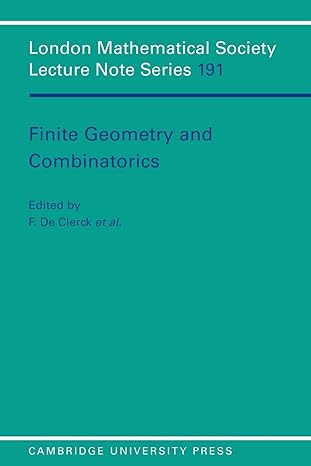Question
5. Which of the following regarding the current yield on a bond isnottrue? a. The current yield is superior to the coupon rate because it
5. Which of the following regarding the current yield on a bond isnottrue?
a. The current yield is superior to the coupon rate because it uses market price instead of face value.
b. The current yield is equal to the coupon rate if the bond is trading at par.
c. The current yield does not account for difference between purchase price and redemption value.
d.The current yield shows the bond's expected rate of return if held to maturity.
6. The yield to maturity for a bond:
- like the current yield takes into account only the interest income payable on the bond.
- is calculated in the same way as the IRR for a capital budgeting project.
- will always be greater than the yield to call since the time horizon is longer.
- does not take into account the reinvestment of interest income from the bond.
7. In
- selling at a discount.
- selling at par.
- selling at a premium.
- a zero coupon bond.
order to have a yield to maturity less than the coupon rate, the bond must be:
- A yield to call calculation:
- a. is best used when the bond is trading at par.
- b. is the same as the YTM but uses the last period in which the bond can be called prior to maturity.
- c. is best used for high coupon bonds trading at a premium.
- d. is only applicable to bonds that have already been called for redemption.
- When interest rates decrease:
- bond prices rise.
- bond prices fall.
- prices of newly issued bonds are lowered.
- interest rates of existing bonds are raised.
- Ifa
- the issuing company may extend the maturity date.
- the bondholder may sell the bond back to the company prior to maturity at her option.
- the issuing company can require the bondholder to sell the bonds back to the company
- prior to maturity.
- d.the bondholder can convert the bond into the issuing company's stock at any time atany time prior to maturity.
- A deferred call provision means:
- a. the bond cannot be called before a certain time.
- b. the bond pays interest on a deferred basis.
- c. the bond is called only in the last year of the term.
- d. the shareholders must defer to the bondholders regarding the call date.
bond is callable, this means:
Page # 2
FMGT 4620-Security Fundamentals SURPRISE QUIZ
- For most bonds the coupon rate is stated:
- as an annual percent and paid annually.
- as an annual percent and paid semi-annually.
- as a semi-annual percent and paid annually.
- as a semi-annual percent and paid semi-annually.
- Which of the following statements regarding changes in bond prices relative to changes in market yields is true?
a. Short-term bond prices will increase more than long-term bond prices if market yields increase.
b. Short-term bond prices will increase less than long-term bond prices if market yields decrease.
c. Short-term bond prices will increase more than long-term bond prices if market yields decrease.
d. Short-term bond prices will remain constant and long-term bond prices will increase if market yields decrease.
- Which of the following bonds would you expect to have the lowest price volatility?
- 8%, 20 year bond
- 8%, 10 year bond
- 4%, 20 year bond
- 4%, 10 year bond
- Duration was designed to:
a. provide a better method to calculate the intrinsic value of a bond.
b. provide bond portfolio managers a method of determining the effect of yield changes on the prices and rates of return for different bonds.
c. provide a way of reconciling computational differences between current yield, yield to call and yield to maturity for different bonds.
d. provide bond managers with a method of pricing bond swap strategies.
16. The duration of a zero-coupon bond:
a. b. c. d.
17.
the following willnotoccur?
- discount bonds will increase in price as maturity approaches
- premium bonds will decrease in price as maturity increases
- par bonds will become more volatile in price as maturity approaches
- par bonds will not change in price over the remaining life of the bond
will be greater than the duration of a coupon bond with the same maturity. will be less than the duration a coupon bond with the same maturity.
will be equal to the duration of a coupon bond with the same maturity.
is impossible to determine.
Assuming that interest rates do not change over the remaining life of a bond which of
Step by Step Solution
There are 3 Steps involved in it
Step: 1

Get Instant Access to Expert-Tailored Solutions
See step-by-step solutions with expert insights and AI powered tools for academic success
Step: 2

Step: 3

Ace Your Homework with AI
Get the answers you need in no time with our AI-driven, step-by-step assistance
Get Started


